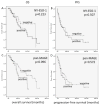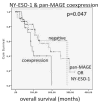Expression and clinical significance of MAGE and NY-ESO-1 cancer-testis antigens in adenoid cystic carcinoma of the head and neck
- PMID: 26874246
- PMCID: PMC5557286
- DOI: 10.1002/hed.24403
Expression and clinical significance of MAGE and NY-ESO-1 cancer-testis antigens in adenoid cystic carcinoma of the head and neck
Abstract
Background: Adenoid cystic carcinoma (ACC) of the head and neck is a rare but highly malignant tumor. Cancer-testis antigens (CTAs) represent an immunogenic family of cancer-specific proteins and thus represent an attractive target for immunotherapy.
Methods: Eighty-four cases of ACC were identified, the CTAs pan-Melanoma antigen (pan-MAGE; M3H67) and New York esophageal squamous cell carcinoma (NY-ESO-1; E978) were detected immunohistochemically (IHC) and correlated with clinical data.
Results: Expression of NY-ESO-1 was found in 48 of 84 patients (57.1%) and of pan-MAGE in 28 of 84 patients (31.2%). Median overall survival (OS) in NY-ESO-1 positive versus negative patients was 130.8 and 282.0 months (p = .223), respectively. OS in pan-MAGE positive versus negative patients was 105.3 and 190.5 months, respectively (p = .096). Patients expressing both NY-ESO-1 and pan-MAGE simultaneously had significantly reduced OS with a median of 90.5 months compared with 282.0 months in negative patients (p = .047).
Conclusion: A significant fraction of patients with ACC show expression of the CTAs NY-ESO-1 and/or pan-MAGE with promising immunotherapeutic implications. © 2016 Wiley Periodicals, Inc. Head Neck 38: 1008-1016, 2016.
Keywords: Melanoma antigen; New York esophageal squamous cell carcinoma (NY-ESO-1); adenoid cystic carcinoma; cancer-testis antigens; head and neck cancer.
© 2016 Wiley Periodicals, Inc.
Figures





Similar articles
-
Simultaneous cytoplasmic and nuclear protein expression of melanoma antigen-A family and NY-ESO-1 cancer-testis antigens represents an independent marker for poor survival in head and neck cancer.Int J Cancer. 2014 Sep 1;135(5):1142-52. doi: 10.1002/ijc.28752. Epub 2014 Feb 11. Int J Cancer. 2014. PMID: 24482145
-
Expression of cancer/testis antigens in salivary gland carcinomas with reference to MAGE-A and NY-ESO-1 expression in adenoid cystic carcinoma.Histopathology. 2017 Aug;71(2):305-315. doi: 10.1111/his.13226. Epub 2017 Jun 2. Histopathology. 2017. PMID: 28370175
-
Predictive and prognostic effect of CD133 and cancer-testis antigens in stage Ib-IIIA non-small cell lung cancer.Int J Clin Exp Pathol. 2015 May 1;8(5):5509-18. eCollection 2015. Int J Clin Exp Pathol. 2015. PMID: 26191258 Free PMC article.
-
Melanoma: a prototype of cancer-testis antigen-expressing malignancies.Immunotherapy. 2017 Oct;9(13):1103-1113. doi: 10.2217/imt-2017-0091. Immunotherapy. 2017. PMID: 29032737 Review.
-
NY-ESO-1 Based Immunotherapy of Cancer: Current Perspectives.Front Immunol. 2018 May 1;9:947. doi: 10.3389/fimmu.2018.00947. eCollection 2018. Front Immunol. 2018. PMID: 29770138 Free PMC article. Review.
Cited by
-
The Co-Expression of Melanoma-Antigen Family a Proteins and New York Esophageal Squamous Cell Carcinoma-1 in Breast Cancer: A Pilot Study.Cancer Manag Res. 2021 Aug 4;13:6123-6128. doi: 10.2147/CMAR.S316759. eCollection 2021. Cancer Manag Res. 2021. PMID: 34377031 Free PMC article.
-
Outcome of Adenoid Cystic Carcinoma of Head and Neck After Postoperative Intensity Modulation Radiotherapy: A Single Institution Study.Cancer Manag Res. 2021 Mar 15;13:2411-2417. doi: 10.2147/CMAR.S283494. eCollection 2021. Cancer Manag Res. 2021. PMID: 33758540 Free PMC article.
-
Biological Rationale and Clinical Evidence of Carbon Ion Radiation Therapy for Adenoid Cystic Carcinoma: A Narrative Review.Front Oncol. 2021 Nov 30;11:789079. doi: 10.3389/fonc.2021.789079. eCollection 2021. Front Oncol. 2021. PMID: 34917512 Free PMC article. Review.
-
NY-ESO-1 expression in solid tumors predicts prognosis: A systematic review and meta-analysis.Medicine (Baltimore). 2019 Nov;98(48):e17990. doi: 10.1097/MD.0000000000017990. Medicine (Baltimore). 2019. PMID: 31770209 Free PMC article.
-
MAGE expression in head and neck squamous cell carcinoma primary tumors, lymph node metastases and respective recurrences-implications for immunotherapy.Oncotarget. 2017 Feb 28;8(9):14719-14735. doi: 10.18632/oncotarget.14830. Oncotarget. 2017. PMID: 28146422 Free PMC article.
References
-
- Büchsenschütz K, Veit JA, Schuler PJ, et al. Molecular approaches to systemic therapy of adenoid cystic carcinoma of the head and neck area. Laryngorhinootologie. 2014;93(10):657–64. - PubMed
-
- Bell D, Hanna EY. Head and neck adenoid cystic carcinoma: what is new in biological markers and treatment? Curr Opin Otolaryngol Head Neck Surg. 2013;21(2):124–9. - PubMed
-
- Park JH, Do NY, Han SI, Lim S-C. Usefulness of the melanoma antigen gene (MAGE) in making the differential diagnosis between pleomorphic adenoma and adenoid cystic carcinoma. J Otolaryngol Head Neck Surg. 2012;41(1):20–9. - PubMed
-
- Laban S, Atanackovic D, Luetkens T, et al. Simultaneous cytoplasmic and nuclear protein expression of melanoma antigen-A family and NY-ESO-1 cancer-testis antigens represents an independent marker for poor survival in head and neck cancer. Int J Cancer. 2014;135(5):1142–52. - PubMed
Publication types
MeSH terms
Substances
Grants and funding
LinkOut - more resources
Full Text Sources
Other Literature Sources
Medical

